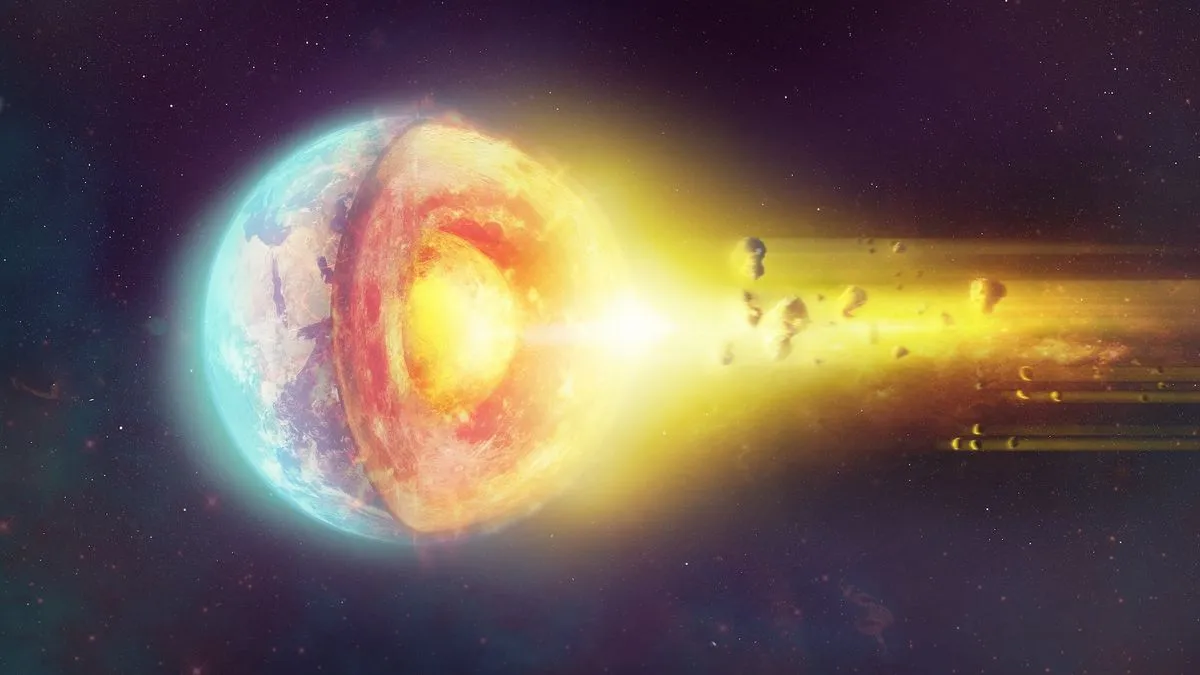
Primordial helium from the earliest days of the solar system could be trapped within Earth’s solid core, according to groundbreaking new research. This discovery has the potential to resolve a long-standing debate regarding the formation timeline of our planet. The rare form of helium in question is known as helium-3, distinguished by its unique nuclear structure, which includes two protons and one neutron. In contrast, the more common form, helium-4, contains two protons and two neutrons and is approximately 700,000 times more prevalent.
While helium-4 primarily arises from the decay of radioactive elements, helium-3 is believed to have originated almost entirely from the primordial cloud of dust and gas that birthed the solar system. Evidence of this ancient element has already been detected within the Earth. Each year, an estimated 4.4 pounds (2 kilograms) of helium-3 escapes from mid-ocean ridges—where tectonic plates separate—and from volcanic hotspots that reach deep into the mantle. However, the mystery remains as to how this primordial helium has persisted within the planet for billions of years.
Helium is an extremely light gas, and most volatile gases have long since escaped the mantle. They were likely blown away during the colossal impact that formed the moon or were released to the surface by the relentless movements of plate tectonics. Scientists have speculated that this primordial helium might be securely locked away in Earth's core, where it would be safeguarded from significant disturbances and could slowly leak to the surface.
However, the core is primarily composed of iron, and traditionally, helium and iron are not known to mix. In a recent study led by Kei Hirose, a planetary scientist at the University of Tokyo, researchers have discovered a surprising compatibility between these two elements under specific conditions. Their findings, reported on February 25 in the journal Physical Review Letters, indicate that at the temperatures and pressures expected in the core, solid iron can contain up to 3.3% helium.
To arrive at these findings, the researchers heated iron and helium to temperatures ranging from 1,340 to 4,940 degrees Fahrenheit (727 to 2,727 degrees Celsius), while simultaneously compressing the mixture using a diamond-tipped anvil to pressures between 50,000 and 550,000 times that of Earth's surface. After the experiments, they depressurized the samples in cryogenic conditions to measure their crystalline structures, a method that likely prevented helium from escaping during the analysis.
While the experiments utilized normal helium-4, it is anticipated that helium-3 would exhibit similar behavior, as noted by Peter Olson, a geophysicist at the University of New Mexico who was not involved in the study but specializes in Earth's core. Olson emphasized that these findings support the notion that helium could remain trapped in Earth's solid inner core for extensive periods. However, he pointed out that only about 4% of the core is solid, indicating that further research is needed to understand the implications for the liquid part of the core as well.
Understanding how helium-3 became incorporated into the core during Earth’s formation is crucial for determining the planet's age. Light gases, including helium, lingered in the gas-and-dust nebula that formed the solar system for only a few million years. There is ongoing debate among scientists about how long it took for Earth to form, with some suggesting it could have taken up to 100 million years. If this were the case, the amount of helium found deep within the Earth would be minimal.
In summary, if researchers can establish that Earth's core contains significant amounts of helium-3, it would strongly indicate that the planet formed rapidly, potentially resolving the ongoing debate about the origins of the solar system. Understanding the complexities of our planet's formation continues to be a fascinating area of study, shedding light on the hidden layers of Earth.